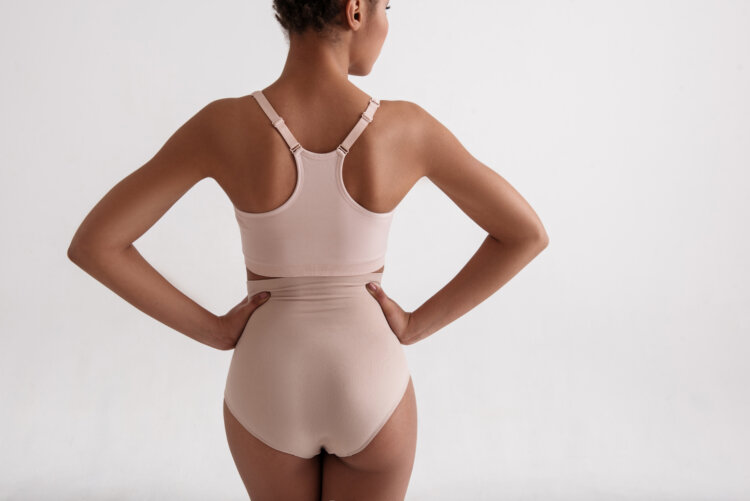
I used to have a side gig selling shapewear in a major department store. I made a nice commission doing so, and I was helping my customers feel more confident in their body-conscious clothing. Win-win, or so I thought.
Eventually, I quit the side gig and ditched my own shapewear collection in favor of comfort (my collection was vast, thanks to freebies from vendors and the fact that we were “encouraged” to wear the product while on the sales floor). When I tossed it, I assumed I was simply liberating myself from ultra-tight undergarments. Little did I know I was actually liberating myself from the possibility of meralgia paresthetica and a host other potentially annoying health concerns.
Meralgia paresthetica, says neurologist Orly Avitzur, the editor-in-chief of Brain and Life magazine, is a neurological condition that occurs when the nerve that carries sensation to the outer thigh (known medically as the lateral femoral cutaneous nerve) gets compressed. Symptoms include numbness, tingling or burning in that region. If you’ve ever been pregnant, the term might be familiar—pregnant women sometimes get it. And apparently, so do frequent users of shapewear. Why? Because shapewear is often just too tight. Either it is designed to make you look a size or two smaller, which naturally requires a lot of compression, or women are making it too tight on purpose by sizing down or even layering (i.e. wearing two or three pairs at once).
But that’s not the only health concern with shapewear. Bladder infections, for example, can be brought on when women delay emptying their bladders to avoid the hassle of getting in-and-out of tight undergarments. Synthetic materials like nylon and Lycra—which shapewear is made out of—are known to trap moisture and heat (especially if they are super tight). The result is an ideal yeast-growing environment which can cause vaginal yeast infections.
And that’s not all! Tight garments can compress your body (including internal organs) to the point where it inhibits proper breathing. Long-term shallow breathing opens the door to a whole host of potential problems such as headaches and increased stress.
“If you are constantly wearing something that impedes the ability of your diaphragm to move, it is not in your best interest,” says MJ Strauhal, a pelvic health rehab specialist at Providence St. Vincent Medical Center in Portland, Oregon. “We want to oxygenate our bodies.”
To make matters worse, the compression and breathing obstruction could also interfere with digestion.
RELATED: Why Mayim quit shapewear
“Constipation would be my biggest concern, Strauhal says. “Digestion relies on freedom of movement, and if you restrict that (movement) it could lead to problems.”
I checked with a gastroenterologist on this, and she concurs.
“We rely on several maneuvers to have a good bowel movement; good breathing and then bearing down and relaxing our anal sphincters,” says Swapna Reddy, a GI specialist at the Oregon Clinic in Tualatin, Oregon. “If we aren’t taking a good breath because of tight shapewear or (are) not able to coordinate our abdominal or pelvic floor muscles because of tight shapewear, that could (lead to constipation).”
What’s more, it can also bring on another GI condition: acid reflux. Tight shapewear is an external force that causes abdominal compression, Reddy explains. This puts pressure on the stomach, which in turns causes acid to reflux up instead of staying down (which it is supposed to do). Next thing you know, you’re taking heartburn medication on the regular. Yikes.
So, does this mean shapewear should be completely eliminated from your wardrobe? Well, not necessarily. Reddy says it is fine to use, just not “continuously throughout the day and night.” And Strauhal, who sometimes recommends shapewear in her practice to patients who could benefit from a little structural support, says common sense should tell us that donning too-tight garments won’t do a body any favors. If you are going to put on shapewear—find shapewear that fits, she says.
Rule of thumb for buying shapewear: Don’t size down. And definitely do not buy multiple products with the intent to layer, despite the fact that actresses have been known to triple layer under a gown for a Hollywood event. When I sold shapewear, we actually advised sizing up, depending on the product.
Avoid garments that are snug in the groin, as well as those that put pressure on that aforementioned outer thigh nerve which, in addition to meralgia paresthetica, could aggravate any existing varicose veins.
And of course, it has to feel right. Avitzur says a good litmus test is whether you are comfortable doing a deep knee bend or reaching for an object. “We all know when a garment is too tight,” she says. “…the best advice is to listen to your body.”


Grok Nation Comment Policy
We welcome thoughtful, grokky comments—keep your negativity and spam to yourself. Please read our Comment Policy before commenting.